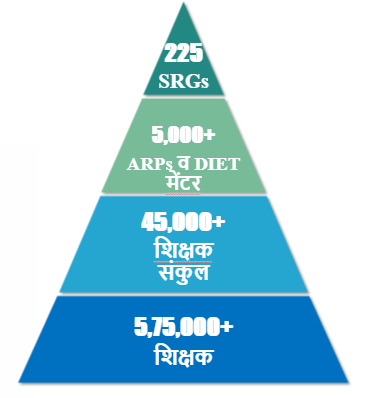4 Elements that make
" Mission Prerna "
a Remarkable Program
Mission Prerna is the flagship program of the Uttar Pradesh government to improve the quality of education in approximately 1.3 lakh schools under the Basic Shiksha Department across the state. The holistic approach of Mission Prerna for improving early learning has been recognised by the national level NIPUN Bharat Mission launched by the Ministry of Education. Since its inception, the efforts of Mission Prerna are translating into extraordinary outcomes of learning and readiness. It is successfully motivating diverse stakeholders to work towards a shared ambition, i.e. improving the foundational learning of students at a very early stage.
Here are 4 reasons why Mission Prerna is able to drive these outcomes while ensuring the trust of its stakeholders in the state of Uttar Pradesh:
1. A positive intention that resonates
In their blog titled ‘Secrets of successful Progams’, Robert Buttrick mentions how programs with ‘positive’ intentions strike chords with their stakeholders. In the past, ASER and National Achievement Survey (NAS) have indicated that major parts of Uttar Pradesh have shown poor learning outcomes. To quote, in the state, less than 60% students in Grades 3, 5 and 8 were able to answer the assessment questions correctly, across subjects. These alarming statistics and an urgent need for action fuelled the objectives of Mission Prerna. Mission Prerna’s focus involves a holistic approach towards attaining foundational learning taking into account the roles played by different personas – parents, teachers, students with special needs and experts. The actions designed to reach these goals kept in mind the needs of teachers and students coming from varying contexts. This inclusivity in its approach sparked interest and alignment among all stakeholders that complemented the efforts of the program.

Message shared with children and parents through advertisements


Assessments conducted in schools to understand clear parameters for school development
2. SMART Goals
The Mission Prerna program has set out with an objective to attain foundational learning for all its students at the primary level. It has SMART Goals (Specific, Measurable, Achievable, Relevant and Time-bound) in place, which supports the team members to plan their efforts in line with the program vision. For instance, under ‘Prerna Lakshya’, a list of all learning outcomes across grades 1-5 for Language and Maths is provided for clarity.
There is a popular saying that goes: ‘If the WHY and WHAT are clear, people can figure out HOW’. When uncertainties like the pandemic and lockdown hit, the team found ways to pivot their plan of action while ensuring alignment with their program objectives. The State found other platforms to ensure smooth communication while they also began experimenting with innovative ways to stay in touch with their students – virtual PTMs conducted by the State Resource Groups (SRGs). Amidst all the activities that were carried out, a dedicated team was assigned to consistently gather and analyse data to ensure a data-driven approach and alignment with the bigger vision and mission of the program.

Goals of Mission Prerna – Prerna Lakshya

Steps specified by department towards achieving goals
3. Spirit of celebration
With a culture of acknowledging and celebrating milestones, Mission Prerna has consistently worked towards driving motivation for all – students, headteachers, block and district level personnel. This can evidently be seen in the frequent YouTube live sessions and other interactions that state officials have with the community where they share all outcomes with immense pride and acknowledge the efforts of each member in attaining them.
At the same time, to recognise the efforts of students and headteachers, the state has introduced appreciation through titles such as ‘Prerak Balak’, ‘Prerak Vidyalay’ and ‘Prerak Head teacher’ awarded to those with exemplary performance. The name and design of the mission lend themselves very well towards such celebrations at each level.

Big goals of the mission

Celebratory spaces for appreciation and recognition
4. Productive Partnerships
To ensure the smooth functioning of the program with such ambitious goals, having partners on board with the vital knowledge, skill-set and expertise become essential. The Head Teachers consistently work towards planning and setting goals for their students. System actors from different cadres that included State Resource Groups (SRGs) and Academic Resource Persons (ARPs) ensure successful dissemination of resources and work towards developing the school as a unit. At the community level, identified community members act as community champions or ‘Prena Saathi’ and contribute to the goals. Prerna Saathis do this by creating awareness for both parents and students of the communities.


Training spaces organised for capacity building of stakeholders

Collaborative team structure for effective implementation
Tags




